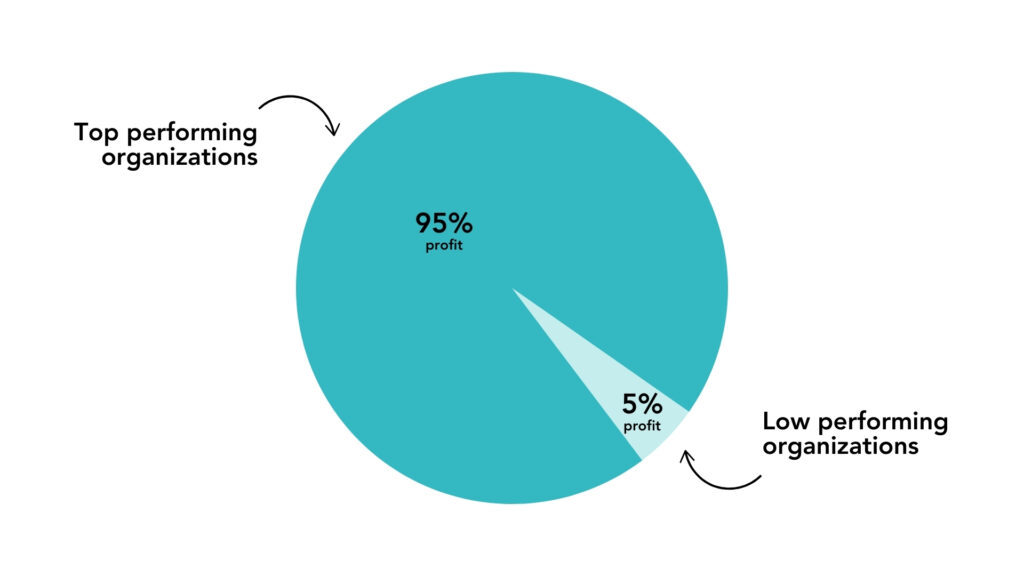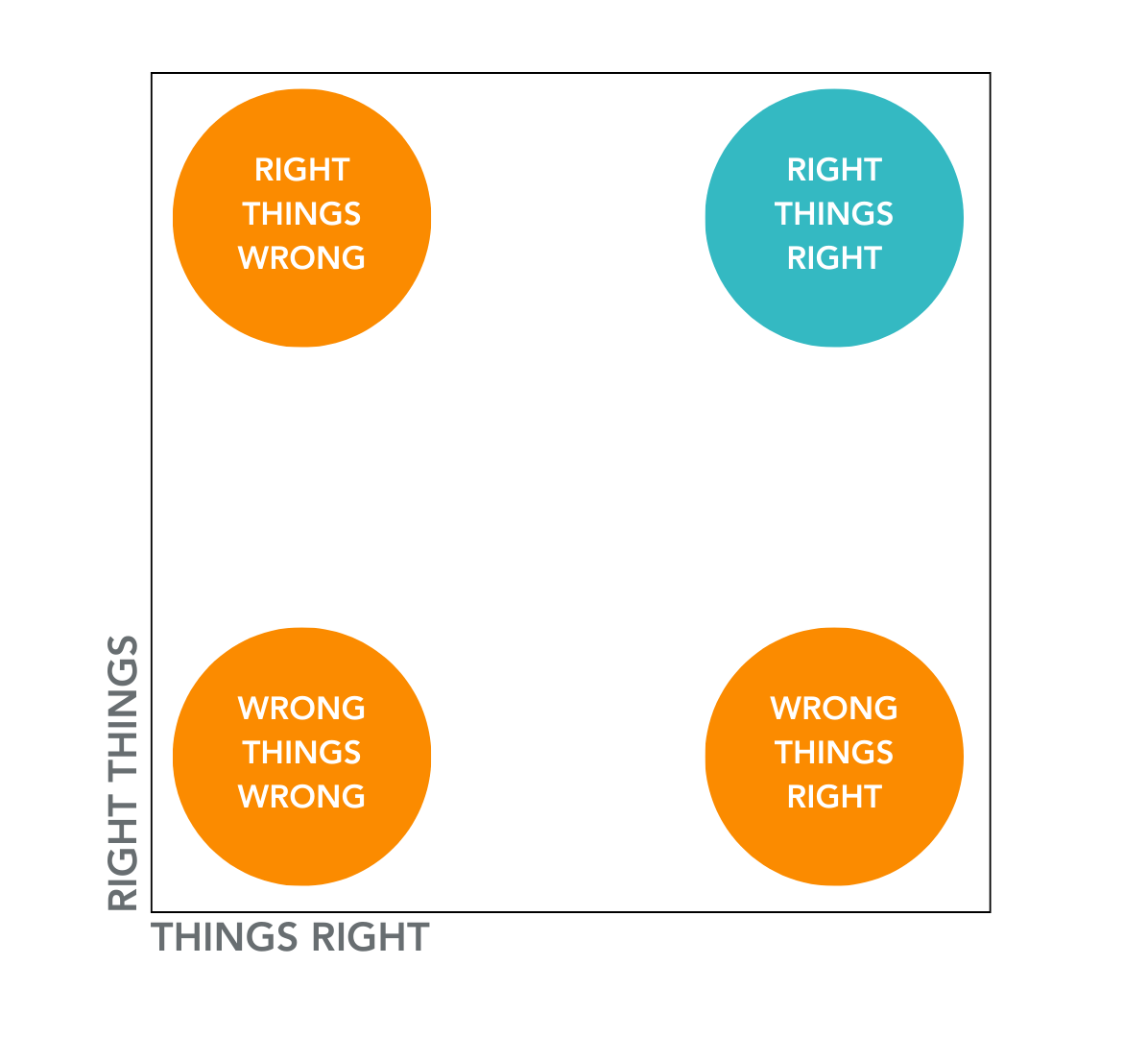Having a clear purpose is more critical than ever
Purpose refers to the reason something exists or is done. It drives our actions, decisions, and goals. It can be said to be the underlying motivation behind our actions and choices. Many studies show that when we connect our purpose to profits, we can make the world a better place while earning more money and attracting the best employees and customers.
Purpose and profit
There is a strong correlation between clarity of purpose (the why) and organizational success. Did you know that 95% of all profits are earned by only 20% of all companies? While the majority of organizations, 80%, share the remaining 5% profits. Interestingly, 96% of the top-performing organizations have high levels of clarity of purpose.[1]This leads me to draw the conclusion that if you have low levels of clarity of purpose for both employees and customers, you have untapped potential in your organization in the form of time, money and energy spent unwisely.

Purpose and motivation
Simon Sinek’s two bestselling books “Start With Why” and “Find Your Why” explain how a strong emotional “why” motivates customers, employees and people in general. Sinek explains that great companies start with why by telling you what they stand for, not what they are selling. They speak emotion rather than logic.
“People don’t buy what you do, they buy why you do it!”
– Simon Sinek, Author of ”Start with why”
Daniel Pink’s studies also show that purpose is a strong driver of motivation.[2] Unfortunately, many leaders can improve when it comes to clarifying the purpose. Studies[3] shows that 93% of workers cannot explain where their company is headed and why. As a result, many leaders experience a gap between strategy and execution.
93% of workers cannot explain where their company is headed and why
When people understand the purpose (the why), they feel valued and can contribute to helping you reach goals and that move you closer to your vision. But if they don’t, they will be demotivated, feel and frustrated as they do not know what to do to help, and hence risk spending time on wasteful activities that waste time, money, and energy.
To succeed in today’s business environment, you must be effective and efficient.
How Effective Is Your Organisation?
There are only 4 ways of doing things.
- Right Things Right: Achieving correct outcomes efficiently.
- Right Things Wrong: Correct goals but inefficient methods.
- Wrong Things Right: Efficiency in unneeded tasks.
- Wrong Things Wrong: Inefficiency in unneeded tasks.

Being efficient but not effective means producing the wrong product or service. Conversely, being effective but not efficient can result in uncompetitive offerings due to factors like slow delivery or high pricing. Understanding this distinction is vital.
It may feel good to be efficient, but doing what should not be done at all is the biggest waste.
“There is nothing so useless as doing efficiently that which should not be done at all.”
– Peter Drucker, regarded as “the father of modern management.”
Clarity of why for employees
When clarity of “why” decreases, Motivation goes down and Time to market goes up. When clarity of “why” increases, Motivation goes up and Time to market goes down.

Reflection:
Can you guarantee that no one in your organization is doing the wrong things right?
Do you leverage the full potential of your organisation?
Purpose and loyalty
The purpose of why also influences customers. When you communicate purpose, you attract the right customers. When customers align with your purpose, they will not only become loyal customers but also become brand ambassadors for your business.
Clarity of why for Customers
When clarity of “why” decreases, sales go down and Cost goes up. When clarity of “why” increases, Sales go up and Cost goes down.

Solutions and Reflections
Proven models exist that can help streamline processes and enhance organizational efficiency. These models are based on what the top performers earning 95% of the world’s profits are doing. They start with why and measure what matters. They leverage their purpose as a unique selling point both internally and externally to improve motivation for both employees and customers.
It really doesn’t matter how clear you as a leader believe your purpose (why) is. You need to confirm that your purpose is as clear for all employees and customers as it is for you and the leadership team.
To increase your effectiveness and efficiency,
you need to start with why and measure what matters.
Starting with why and measure what matters is much more than having a clear purpose. It is about bridging the gap between strategy and execution by aligning the everyday work done in your organization with your purpose and vision. A way of doing this is using the BIG framework® Start with why model.
Learn more about this model here.
Modern leaders know how to operate the Start with why and measure what matters model, making sure they align their strategies with the day-to-day work in their organisation. These leaders make sure:
- The purpose is clear to all employees and customers.
- Values are activated through daily habits by leaders and employees.
- The vision is measurably clear to all employees.
- The vision has a roadmap in the form of validated and prioritised business opportunities (BOS) that everybody understands.
- OKRs are created by all employees and align with the prioritised BOS and measurements are clearly defined.
- Bonus systems are transparently connected to the fulfilment of reaching strategic metric targets.
- Recognition and celebration of goal achievements are public.
When leaders make sure these seven points work, they release their organisation’s true potential and minimize wasteful work. Smart leaders leverage their purpose as a unique selling point both internally and externally.
A well-known company that has leveraged this is Google. Here is what co-founder Larry Page said:
“OKRs have helped lead us to 10x growth, many times over”.
– Larry Page, co-founder of Google
Why did OKR´s help Google grow? It helped the leaders connect strategy to the everyday work done by team members across the entire organisation. Gmail and YouTube user logins are both great examples of OKRs that were created by workers at Google because the leaders had clearly articulated the business opportunities.
When John Doerr introduced the goal and performance management method OKR to Google in 1999, the company was not yet one year old and had just 40 employees. Today, Google belongs to its parent company Alphabet, employs approximately 180,000 people and still uses the OKR method.
This goes to show that this model works no matter what size your organization is.
What is amazing with Google is also that they showed the world that you do not have to be the first with an idea to be the winner. What means the most is how well you execute. Google was the fifth “search engine” company to enter the market, but it managed to outperform all its competitors using the full potential of every Google employee. Apple has plenty of competitors, but none of them have as loyal customers as Apple. Where else do you see queues outside shops at a product launch?
Steve Jobs, confirmed the importance of values which is part of the Big Framework® – Start with why model as shown in Apple’s marketing. They show that communicating why is far more effective than communicating what. Apple’s iPods advertisement is a prime example of this and only said:
“1000 songs in your pocket “
Apple’s advertising resonated with consumers far better than competitor’s communication of technical features of their MP3 players.
Key Takeaways
Your leadership responsibility extends beyond strategy formulation to ensuring its execution. By helping your people understand and align their work with strategic goals, you empower them to contribute meaningfully, enhancing effectiveness and efficiency. There is a reason why both Google and Apple are attractive places to work: people want to work where they have a chance to contribute and learn. Your purpose is equally powerful when it comes to customers. A clearly communicated purpose can set you apart from your competitors; it can be a powerful selling point to attract the right customers who stay loyal and bring their friends.
Are you ready to unleash your organization’s full power and consistently meet your quarterly targets?
[1] Organizing for the future: Nine keys to becoming a future-ready company
[2] Drive: The Surprising Truth About What Motivates Us by Daniel H. Pink
[3] Measure what matters by John Doerr.


